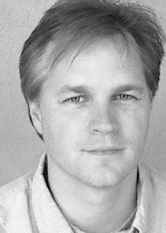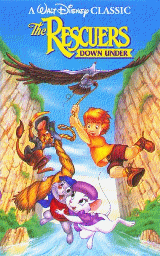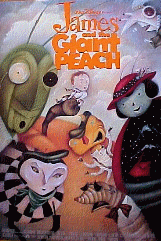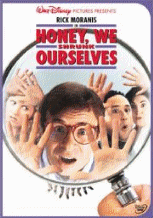|
Find interviews by: | ||
Karey Kirkpatrick (Part 1) Originally published in SFX in early 1998, this was, I believe, the first major interview with Karey Kirkpatrick. At the time, he was working on Chicken Run and a Thunderbirds movie which eventually fell apart (for reasons unconnected with the script). I prophecied big things for Karey, who more recently worked on the screenplay for The Hitchhiker's Guide to the Galaxy. Jump straight to Part 2 of this very long interview
"I went to film school at USC. While I was there, my partner Byron Simpson and I wrote an animated screenplay, which not too many people do because at the time there was really only one market for it, which was Disney. But I have a musical theatre background - started as an actor - and he and I wanted to write musicals because we both write music. So our first thinking was: where can we do this and make money? And our first thought was Disney. So we wrote this musical and brought it to them and played it for them. They had a piano in an office there; he sat down and played and we sang the songs, and at the end said, ‘What do you think?’ And after a little bit of discussion they called us and said, ‘Look, we don’t like this particular project, but we like the talent.’ Because they were in the business of doing musicals. It was a little bit rare to have somebody who wrote all three - wrote music, lyrics and dialogue - so it was something that they weren’t looking for. ”So they brought us on board as summer interns. We wrote a few Mickey Mouse shorts, and they liked the way we wrote dialogue. At that time The Rescuers Down Under was a script that was in need of some work, so they asked us to come in and tell them what’s wrong with Rescuers, and what would you do to fix it? So we did that, and they said,, ‘Okay, why don’t you come on board and write that?’ and they offered us a full-time staff position. So for three years I was a staff writer, with Byron as a partner, at Disney. Rescuers was the only thing that I wrote that got produced because they only make one a year, so the ratio of scripts developed to scripts produced is pretty high." Did you find that material from unproduced scripts could be revamped into new scripts? "No, I found that they pretty much owned every idea that I uttered. So if there were any ideas that I had that I wanted to do later, I had to pretty much keep them to myself. There were a couple of original ideas that I had, that I worked on, but when I left there they belonged to Disney. Pretty much the way it worked was that we would go in and have development meetings every Monday. Then after I’d finished one project, they’d say: ‘Okay, this week you’re going to be doing Romeo and Juliet - with ants.’ I actually did work on that. You work on it for a while, then send the treatment off to Jeff Katzenberg and he gives you the thumbs up or the thumbs down." How many staff writers do Disney have? "At this time there were probably about six, I would say, off and on, doing all sorts of different things. When I started there, Oliver and Co. was being made, so it was really before this animation renaissance. The next film that they did was The Little Mermaid, and that was really big. Then Rescuers after that. Unfortunately, Rescuers got sandwiched between Little Mermaid and Beauty and the Beast, which were their two biggest of all time. Rescuers was the first one where they didn’t use cels. They had perfected a process of going from computers to film. It was always hand-drawn, but the inking and painting and photography was gone."
"That’s right. And that’s why the opening of Rescuers is really spectacular. A boy goes out and goes flying with this eagle. The opening shot is a tracking shot across the Outback towards Ayers Rock, with all this stuff rushing by. It’s stuff you really couldn’t have done in the old style of animation, because you’re limited by things you stack up in a room. I think that opening shot moves through 32, 35 different planes. It was breathtaking." Did they put you and your partner on this because it was a new technique, and new writers wouldn’t be hidebound by previous conventions? "No, we had got put on board because we had written a couple of Mickey Mouse featurettes, that they were doing back then. They released one called The Prince and the Pauper which we didn’t write. They were doing lots of ‘Mickey in classic fairy tales’: Mickey in The Emperor’s New Clothes, Mickey the Pied Piper." Were these for TV? "No. They released one as a short before Rescuers, a twenty-minute thing. I think they were going to do them as video. When we were writing those, we got known as being pretty good at telling a story without using too much dialogue. The problem most live-action writers have when they come into animation is depending too much on dialogue. So the trick in any situation is to try to let a picture tell a thousand words, and it’s even more true in animation because it’s a superficial medium. So I guess they just saw something there. It was great, it was a really great experience working at Disney. When Byron and I worked on that there were also nine storyboard artists, all in the same vicinity. We would write something; a storyboard artist would take it and board it, then they would give it back to us. They had made changes, and then we would refine what they did. It was close to collaboration. That was my first professional writing experience at age 23, 24: baptism by collaboration. And I never got into that frame of mind of being set in my work. I got used to being a member of a team, and I guess that was an attractive feather in my cap. It was really invaluable." Did you get the job at Disney because of your connections from working at EPCOT? "Well, indirectly, because when I worked at EPCOT, I did improvisational theatre for a company that was subcontracted by Disney." Was that basically keeping people happy while they’re queuing? "At EPCOT, they have all those different Pavilions, representing the different countries. They have the Mexican Pavilion, the Morrocan Pavilion, the Italian Pavilion, and each one is different. I worked in the Italian and the United Kingdom Pavilion doing audience participation street theatre, like the stuff you see at Covent Garden. In fact the troupe that I worked with performed at Covent Garden, although I never did." Had you been to Britain? "I had never been. My first trip to Britain was after writing James and the Giant Peach. I had been to Paris, but never Britain. We did bastardised versions of Romeo and Juliet, things like that, with really bad fake British accents. That was also a great experience. And here again, that was where I first started deciding I wanted to write. One of the guys from that troupe, he left that company and came down here, started working for Walt Disney. So he was the one who made the initial phone-call: ‘I know this guy. I saw the script that he wrote. I think you should take a look at it.’ it does depend on who you know." After you’d done Rescuers, was James the next film you did? "No, I actually wrote a film for Propaganda Films, which was a small company producing videos. That’s where David Fincher came from. They were starting to branch into features. They had done Candyman, Kalifornia. They had the rights to a children’s book, The Little Vampire. I was hired to write that screenplay, which I did. Then they sent it to Disney, asking if they wanted to co-produce. I had just gotten off three and a half years at Disney, and they sent me right back. Disney replied, ‘No, we’re not interested in making this.’ But one of the executives over there had read the script, was reminded of me, and he rang me up and said, ‘Why don’t you come in and have a crack at Honey, We Shrunk Ourselves? We have this idea for a new Honey movie.’" Was that when it was still planned for a theatrical release? "They sent it to Jeffrey and Jeffrey decided, ‘No, I don’t think we’re going to continue this script.’ So it sat there for a little while, but off of that script, David Vogel, the President of Disney, read the script and really liked my first draft. So he called and said, ‘We have a script that needs attention.’ They were going to shelve the current draft of James and the Giant Peach, so David said, ‘Before you do that, let’s have one more crack at it.’ So he sent it out to a few different writers. As a writer, you get a script and get asked: ‘Read this. Tell me what’s wrong.’ I knew the book - I’d read a lot of Roald Dahl - so I read it and I wrote up a twelve-page document: here’s what I would do to fix this. I met with Henry Selick. And that’s how I got the job."
"I’m pretty sure it always was, right from the beginning. Nightmare Before Christmas had been about 80 minutes long at a cost of something like $25-30 million. They wanted James to be longer, but couldn’t afford to give it a bigger budget, so they decided one way would be to have a live-action framing story. So it was already like that when I came on board, and I’m pretty sure that the concern at first was budgetary. I think they could probably have done it all as stop-motion, but I’m not sure it would have worked. Because this voyage across the ocean was a breaking point in the story, like The Wizard of Oz." It’s also a bit like The Phantom Tollbooth. "Yes, it follows a relatively classic structure, which makes it difficult, from the movie’s standpoint, to give it a through-line. That’s one of the first things that I noticed as soon as I came on board; that in order for this to work as an hour-and-a-half movie, it needed something that connected the beginning and the end. So I suggested the two aunts, who gave him the sense of adventure and mystery. I met with Lucy Dahl beforehand. She had some say in who she would like to write the script. As I explained it to her, a book - especially a children’s book - commands a different kind of storytelling. Very few people read a book in one sitting, and a lot of times parents are reading this book to their children. You can read a chapter at a time, and by the time you get to chapter ten or twelve, you’re not that concerned with what happened in chapter one, tying all the plot up. But in a 75-minute movie, it was just 75 minutes ago that you set this ball rolling. It would be nice to have everything resolved and come together at the end. So the biggest change that we made, that people still come to me and say: ‘Why didn’t you kill the aunts right away?’ I tell them that we have to have them show up in New York City. It’s something for James to overcome to show that he’s grown." You adapted that into a children’s book, as well. "That was actually Lucy Dahl’s doing. Lane Smith had done all these incredible drawings for the movie [Not this Lane Smith - MJS]. That was his job: conceptual designer. He designed the look of the characters and so on. He had about twenty drawings that he did, and the storyboard artists and the model-makers used them as a point of inspiration. After we were done, Lucy would see these drawings and say, ‘They’re breathtaking. What will happen to them?’ ‘Oh, they’ll be buried in the Disney archives somewhere.’ So she said, ‘Why not release them as a children’s book, telling the story of the movie?’ And she very kindly suggested that I be the guy to write the story to go with them. That’s how that came about. The only thing that Lane had to generate for the book, was that he hadn’t done any drawings for the live-action sections of the story, so he drew about five more pictures, and that became the book." After James, did you go back to Honey? "Well, during James I was actually working on another film for Disney, just another assignment. I found out, during the making of James, that they were going to make Honey as their first straight-to-video film. The reason they could do that is that by going to television resolution you can save money on the effects, by not having to get it to a projectable format. So they were going to give that a shot, and decided while I was on James to bring in another writing team to rewrite the script I had done." So you weren’t involved in altering it from a $40 million script down to a $7 million script? "No. I was on James at the time, so they brought somebody else in."
"Yes. The finished product, I thought was really good, with some good laughs in it [See also my interview with the film's director, Dean Cundey - MJS]. The only disappointment for me, was that when I had originally written it, the premise is that the kids think that the parents are away and have a party. In my head, that party escalated into something that’s more akin to Sixteen Candles or Say Anything, a huge party, out of control, with 150 kids." In the end it was about five or six. "In the end it was nine, politely listening to music. I hd pictured something much more out of control. But that’s very costly, having that many extras for that many days. It makes it a much more complicated production. So that’s the only part that was a little less than what I had expected. The Hot Wheels sequence was in my first draft, so that was nice to see. It was a fun script to do, because I could walk round my house and think: where would be an interesting place to be if you were a quarter-inch tall? I had a sequence where they fell in the aquarium. Whereas in this one they float in a soap bubble, in my version I had them rise out of the aquarium in a bubble from the aerator. It really was fun to see that script, because it had been held then resurrected." Continue to Part 2 of this very long interview, where Karey Kirkpatrick discusses Chicken Run and the Thunderbirds movie that never was | ||




